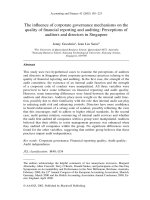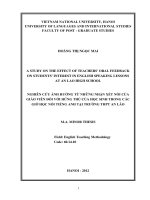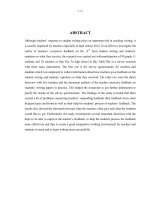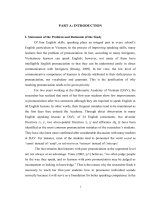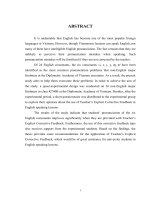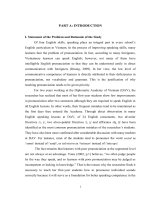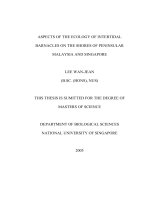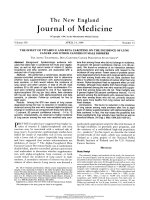TEACHERS CORRECTIVE FEEDBACK ON THE PRONUNCIATION OF ENGLISH FRICATIVES AND AFFRICATES BY NON-ENGLISH MAJOR FRESHMEN
Bạn đang xem bản rút gọn của tài liệu. Xem và tải ngay bản đầy đủ của tài liệu tại đây (773.76 KB, 91 trang )
ABSTRACT
It is undeniable that English has become one of the most popular foreign
languages in Vietnam. However, though Vietnamese learners can speak English,
not many of them have intelligible English pronunciation. The fact remains that
they are unlikely to perceive their pronunciation mistakes when speaking. Such
pronunciation mistakes will be fossilized if they are not corrected by the teacher.
Of 24 English consonants, the six consonants /s, z, ʃ, ʒ, ʤ, ʧ/ have been
identified as the most common pronunciation problems that non-English major
freshmen at the Diplomatic Academy of Vietnam encounter. As a result, the present
study aims to help them overcome these problems. In order to achieve the aim of
the study, a quasi-experimental design was conducted on 36 non-English major
freshmen in class KT40B at the Diplomatic Academy of Vietnam. Besides, after the
experimental period, a short questionnaire was distributed to the experimental group
to explore their opinions about the use of Teacher’s Explicit Corrective Feedback in
English speaking lessons.
The results of the study indicate that students’ pronunciation of the six
English consonants improves significantly when they are provided with Teacher’s
Explicit Corrective Feedback. Furthermore, the use of this corrective feedback type
also receives support from the experimental students. Based on the findings, the
thesis provides some recommendations for the application of Teacher’s Explicit
Corrective Feedback, which would be of great assistance for university students in
English speaking lessons.
i
LISTS OF TABLES
List of Tables
Table 1: English Consonants
Table 2: Similarities and Differences of English Alveolar Fricatives, Alveo-
Palatal Fricatives and Affricates
Table 3: Percentile Rank of the Pre-test Scores of KT40B Students
Table 4: Placements of 34 Subjects in Pairs for Random Assignment
Table 5: Frequency of the Pre-test Scores
Table 6: The Scoring Process in the Experimental Subgroup 1
Table 7: The Scoring Process in the Experimental Subgroup 2
Table 8: Results of the Pre-test and Post-test of Both Groups
Table 9: Comparison of the Pre-test Scores of Two Groups
Table 9a: Paired-samples Statistics (Pair 1)
Table 9b: Paired-samples T-test (Pair 1)
Table 10: Comparison of the Gain Scores Made by Two Groups after the
Experimental Period
Table 10a: Paired-samples Statistics (Pair 2)
Table 10b: Paired-samples T-test (Pair 2)
Table 11: Comparison of the Post-test Scores of Two Groups
Table 11a: Paired-samples Statistics (Pair 3)
Table 11b: Pair-samples T-test (Pair 3)
Table 12: The Experimental Group’s Opinions about TECF on Their
Pronunciation of the Six Consonants /s, z, ʃ, ʒ, ʤ, ʧ/
ii
LISTS OF FIGURES AND ABBREVIATIONS
Lists of Figures
Figure 1: The Process of Providing Pronunciation-Focused TECF on Students’
Output
Figure 2: Differences in Gain Scores Obtained by Both groups after the
Experiment
Figure 3: The Experimental Group’s Opinion about TECF on Their
Pronunciation of the Six Consonants /s, z, ʃ, ʒ, ʤ, ʧ/.
Lists of Abbreviations
DAV: Diplomatic Academy of Vietnam
TCF: Teacher’s Corrective Feedback
TECF: Teacher’s Explicit Corrective Feedback
L2: Second Language
FL: Foreign Language
S: Student
iii
TABLE OF CONTENTS
ACKNOWLEDGEMENT i
ABSTRACT ii
LISTS OF TABLES iii
LISTS OF FIGURES AND ABBREVIATIONS iv
PART A: INTRODUCTION 1
I. Statement of the Problem and Rationale of the Study 1
II. Aim and Objectives of the Study 3
III. Research Hypothesis and Research Questions 4
III.1. Research Hypothesis 4
III.2. Research Questions 4
IV. Scope of the Study 5
V. Methodology 5
VI. Significance of the Study 6
VII. An Overview of the Rest of the Paper 6
PART B: DEVELOPMENT 8
CHAPTER I: LITERATURE REVIEW 8
I.1. The Importance of Pronunciation Teaching and Learning 8
I.2. Aspects of Pronunciation 9
I.3. The Aim of Teaching Pronunciation: Intelligibility 10
I.4. General Description of Consonants and English Consonants 12
I.5. English Fricative Consonants 14
I.5.1. Production of English Alveolar Fricatives: /s, z/ 14
I.5.2. Production of English Alveo-palatal Fricatives: /ʃ, ʒ/ 15
I.6. English Affricates: /ʤ, ʧ/ 15
I.7. Previous Studies on Vietnamese Learners’ Pronunciation of the Six
English Consonants /s, z, ʃ, ʒ, ʤ, ʧ/ 16
I.8. Teacher’s Corrective Feedback 18
I.8.1. Definition of Teacher’s Corrective Feedback 18
I.8.2. Types of Teacher’s Corrective Feedback 19
I.9. Teacher’s Explicit Corrective Feedback 21
I.10. Theoretical and Empirical Background on TECF 23
I.10.1. Theoretical Background on TECF 23
I.10.2. Empirical Background on TECF 25
I.11. Research Gap 26
CHAPTER II: METHODOLOGY 27
II.1. Context of the Study 27
II.2. Study Design 28
II.3. Selection of the Main Subjects for the Study 31
II.4. Assignment of the Subjects to the Experimental and Control Group 32
II.5. Instruments for Data Collection 35
II.6. Instrument for Data Analysis 39
II.7. Treatment to the Experimental Group and Control Group 40
II.8. Integration of Pronunciation Targets into the English speaking lessons 47
CHAPTER III: RESULTS 51
III.1. Comparison of the Pre-test and Post-test Scores 51
III.1.1. Comparison of the Pre-test Scores of Both Groups 52
III.1.2. Comparison of the Gain Scores of Both Groups after the
Experiment 53
III.1.3. Comparison of the Post-test Scores of Both Groups 56
III.2. The Experimental Group’s Opinions about TECF on
their Pronunciation of the Six English Consonants /s, z, ʃ, ʒ, ʤ, ʧ/ 57
CHAPTER IV: DISCUSSION 61
IV.1. Discussion of Both Groups’ Pronunciation Gain Scores and Post-test
Scores after the Experimental Period 61
IV.2. Discussion of the Experimental Group’s Opinions about TECF
on Their Pronunciation of the Six English Consonants /s, z, ʃ, ʒ, ʤ, ʧ/. 63
IV.3. Recommendations for the Application of TECF in English
Speaking Lessons 65
PART C: CONCLUSION 67
I. Conclusion 67
II. Limitations of the Study 68
III. Recommendations for Further Studies 69
REFERENCES 70
APPENDICES I
APPENDIX 1: PRE-TEST II
APPENDIX 2: POST-TEST V
APPENDIX 3: PICTURE DESCRIPTION ACTIVITY VIII
APPENDIX 4: QUESTIONNAIRE (ENGLISH) X
APPENDIX 5: QUESTIONNAIRE (VIETNAMESE) XI
PART A: INTRODUCTION
This chapter sheds light on the research problem and rationale of the study as
well as its scope and significance. More importantly, the aim and objectives of the
study are emphasized with its research questions. Finally, the chapter concludes
with an overview of the rest of the paper, which serves as an orientation for readers
throughout the research.
I. Statement of the Problem and Rationale of the Study
As a member of World Trade Organization, Vietnam has given foreign
languages in general and English in particular a greater role than ever before for the
purpose of attracting foreign investment and promoting the economy. As English is
widely used in many international settings, the ability to communicate in real-life
situations is of great importance. Therefore, of four English skills, speaking plays
an integral part in every school’s English curriculum throughout the country.
In the process of improving speaking skills, many learners face the problem
of pronunciation. In fact, according to many foreigners, Vietnamese learners can
speak English; however, not many of them have intelligible English pronunciation
so that they can be understood easily in direct communication with foreigners
(Duong, 2009). In her view, the low level of communicative competence of learners
is directly attributed to their deficiencies in pronunciation, not vocabulary and
grammar. This is the justification of why teaching pronunciation needs to be given
priority.
For two years working at the Diplomatic Academy of Vietnam (DAV), the
researcher has realized that most of her first-year students show few improvements
in pronunciation after two semesters although they are required to speak English in
all English lessons. In other words, their frequent mistakes tend to be maintained as
the first days they entered the Academy. Through direct observation in many
English speaking lessons at DAV, of 24 English consonants, two alveolar
1
fricatives /s, z/, two alveo-palatal fricatives /ʃ, ʒ/ and affricates /ʤ, ʧ/ have been
identified as the most common pronunciation mistakes of the researcher’s students.
They have also been more confirmed after considerable discussion with many teachers
at DAV. For instance, most of the students tend to pronounce the word social as /
ˈsəʊsl/ instead of /ˈsəʊʃl/, or television as /ˈtelɪvɪzn/ instead of /ˈtelɪvɪʒn/.
The fact remains that learners with poor pronunciation at the segmental level
are not always at an advantage. In Tench (1981, p.17-20, as cited in Chung),
“spoken language is a social act, and you are expected to fulfill many of the
listener’s expectations and needs.” Therefore, “the more of these are violated, the
harder it will be on the listener, and the more “points” will be taken off by listeners
in their judgment of the speaker” (Chung, p.2). This view is echoed by Yates (2002,
p.1) who believes, “we often judge people by the way they speak, and so learners
with poor pronunciation may be judged as incompetent or lacking in knowledge.”
That is the reason why the researcher finds it necessary to teach her first-year
students how to pronounce individual sounds correctly because it will serve as a
foundation for better speaking competence in the next three years. In order words,
they need to start with individual sounds before moving on other complicated
aspects of speech such as intonation, stress, etc.
With regard to the coursebooks used by freshmen in English speaking
lessons at DAV, namely Let’s talk 2 in the first semester and Let’s talk 3 in the
second semester, they do not consist of any sort of pronunciation work on
individual sounds. Instead, they contain a variety of speaking activities for the
purpose of developing students’ oral communication skills and fluency. The
employment of these books presumes students to acquire basic knowledge of
pronunciation, including English consonants, to get involved in different English
conversations. However, in many situations, when a student delivers a talk,
mistakes like /ˈsəʊsl/ and /ˈtelɪvɪzn/ seem not to be perceived. Furthermore, those
who are less likely to notice such pronunciation mistakes are non-English majors.
2
From the researcher’s viewpoint, the problem lies in the fact that students do
not receive adequate feedback from the teacher on their pronunciation performance.
In other words, they need to be assisted by the teacher to realize their problems.
Kenworthy (1987, p.2) comments:
Learners need to know what to pay attention to and what to work on.
Because speaking is for the most part unconsciously controlled, learners may
miss something important. For example, they may not realize that when a
particular word is stressed or said in a different way this can affect the
message that is sent to the listener. Teachers need to make learners aware of
the potential of sounds. (Kenworthy, 1987, p.2)
It is suggested that Teacher’s Corrective Feedback (TCF) can be used to help
learners perceive and discard what is unacceptable or inappropriate from their
interlanguage. In simple words, the students will have a clear picture of what they
are weak at and what they need to improve. Considering the benefits TCF can bring
to learners of English, the researcher wants to determine if TCF can solve her
students’ pronunciation problems in terms of the six English consonants /s, z, ʃ, ʒ,
ʤ, ʧ/ in English speaking lessons where pronunciation work is not included.
Last but not least, research into TCF on pronunciation mistakes in English
speaking lessons at university level in Vietnam is quite small in number. All the
aforementioned reasons have motivated the researcher to conduct this quasi-
experimental research on Teacher’s Corrective Feedback on the pronunciation
of English fricative and affricate consonants by non-English major freshmen at
the Diplomatic Academy of Vietnam.
II. Aim and Objectives of the Study
The study aims at helping non-English major freshmen at DAV improve their
pronunciation of the six consonants /s, z, ʃ, ʒ, ʤ, ʧ/.
To be specific, the primary objectives of the study are as follows:
• To examine the effect of TECF on the pronunciation of the six consonants /s, z,
ʃ, ʒ, ʤ, ʧ/ by non-English major freshmen at DAV;
3
• To investigate the experimental students’ opinions about TECF on their
pronunciation of the six consonants /s, z, ʃ, ʒ, ʤ, ʧ/ after the experimental
period.
III. Research Hypothesis and Research Questions
III.1. Research Hypothesis
A hypothesis is constructed for the purpose of achieving the aim of the study:
H
1
: Non-English major freshmen who receive TECF make more significant
improvements in their pronunciation of the six consonants /s, z, ʃ, ʒ, ʤ, ʧ/ than
those who do not receive TECF.
If the above hypothesis is fully accepted, the following null hypothesis will
be obviously rejected or vice versa:
H
o
: There is no difference in the pronunciation of the six consonants /s, z, ʃ,
ʒ, ʤ, ʧ/ between non-English major freshmen who receive TECF and those who do
not.
In order to identify which hypothesis will be accepted, the first research
question, posed in Section III.2, needs to be satisfactorily answered.
III.2. Research Questions
Based on the aim and objectives of the study, two questions were formulated
and needed to be satisfactorily answered:
(1) What is the difference that Teacher’s Explicit Corrective Feedback brings about
in the pronunciation of the six consonants /s, z, ʃ, ʒ, ʤ, ʧ/ by non-English major
freshmen at the Diplomatic Academy of Vietnam?
(2) What are the experimental group’s opinions about Teacher’s Explicit Corrective
Feedback on their pronunciation of the six consonants /s, z, ʃ, ʒ, ʤ, ʧ/ after the
experiment period?
4
IV. Scope of the Study
Initially, corrective feedback as stated in the research title is, in fact, confined
to Explicit Corrective Feedback, one type of TCF in a study of Ellis, Loewen &
Erlam (2006, as cited in Fawbush, 2010), for the reasons elaborated on in the
Literature Review Chapter.
Regarding English fricative consonants, the study focuses on two English
alveolar fricatives /s, z/ and two alveo-palatal fricatives /ʃ, ʒ/. When it comes to
English affricate consonants, they are /ʤ, ʧ/. Only issues concerning the pronunciation
of these sounds are taken into consideration.
Finally, it should be noticed that 36 non-English major freshmen in the class
KT40B at DAV were involved in the study but only 34 students were eligible to
become its main subjects. The process of selection will be elaborated in the
Methodology Chapter.
V. Methodology
A quasi-experiment was adopted in this study so as to test the research
hypothesis stated in Section III.1. First, based on a pre-test of the six consonants /s,
z, ʃ, ʒ, ʤ, ʧ/ administered to 36 students in the class KT40B, 34 participants were
selected and assigned into two groups, control and experiment. Then, they
participated in a ten-week experiment, in which a 30-minute instruction on the six
consonants /s, z, ʃ, ʒ, ʤ, ʧ/ was delivered to both groups at the beginning of every
lesson. Afterwards, they got involved in a number of the same speaking activities;
however, only the experimental group received TECF on their pronunciation
mistakes regarding /s, z, ʃ, ʒ, ʤ, ʧ/. Meanwhile, the control group got feedback on
the content of their statements or arguments. After the experimental period, both
groups sat for a post-test (version of the pre-test). The pre-test and post-test scores
were analyzed by means of paired-samples t-tests to find out the answer to the first
research question. Besides, a short written questionnaire was employed as the
supplementary instrument to investigate the experimental students’ opinions about
5
TECF on their pronunciation mistakes regarding /s, z, ʃ, ʒ, ʤ, ʧ/ after the
experiment.
VI. Significance of the Study:
As one of the trail-blazing studies on the impact of TECF on the
pronunciation of English consonant sounds by Vietnamese university students, the
study would be of great benefit for two reasons:
Initially, the research outcome could be used as evidence of the impact of
TECF on Vietnamese university students’ pronunciation of the six consonants /s, z,
ʃ, ʒ, ʤ, ʧ/, which are believed to be one of the biggest problems that most of them
encounter. As for English teachers in general and English teachers at DAV in
particular, they could base themselves on the results of the paper to make informed
decisions on whether TECF should be encouraged or not. In fact, if there exists a
positive link between TECF and students’ pronunciation of the six consonants /s, z, ʃ,
ʒ, ʤ, ʧ/, it can bring about a significant change in many English speaking lessons at
colleges and universities, where pronunciation work is not included.
In addition, this study can serve as a reliable source of related literature and a
basis for other researchers, who share an interest in the topic, to start their future work
from.
VII. An Overview of the Rest of the Paper:
The rest of the paper consists of two main parts:
PART B: DEVELOPMENT
This part is divided into three chapters:
CHAPTER I: LITERATURE REVIEW - establishes the solid foundation for the
whole paper. Besides clarifying the key terms such as pronunciation, intelligibility,
English fricatives and affricates, Teacher’s Explicit Corrective Feedback, the chapter
offers a critical review of related studies.
6
CHAPTER II: METHODOLOGY - clarifies the reason why a quasi-experimental
design is employed in this study. Furthermore, it also elaborates on the context of the
study, the selection of the main subjects, the instruments for data collection and
analysis, and the treatment to the experimental and control group.
CHAPTER III: RESULTS - presents and analyzes all the collected data to find out
the answers to the research questions.
CHAPTER IV: DISCUSSION - presents the researcher’s discussion based on the
research findings. Furthermore, it also offers some recommendations for the
application of TECF in English speaking classrooms.
PART C: CONCLUSION
This part summarizes all the major points raised in the paper. Furthermore, it also
indicates the limitations of the study as well as some suggestions for further studies.
7
PART B: DEVELOPMENT
CHAPTER I: LITERATURE REVIEW
This chapter provides an overview of the literature related to this study,
establishing a solid foundation for the whole paper. Not only are key terms like
pronunciation, intelligibility, English fricatives and affricates, Teacher’s Explicit
Corrective Feedback clarified but background information about the key terms is
also presented to ensure a thorough understanding of the research matters. Besides,
the research gap is also revealed in this chapter.
I.1. The Importance of Pronunciation Teaching and Learning
Gilakjani (2012) considers pronunciation as a set of habits of producing
sounds, which is acquired by repeating the sounds over and over again and by being
corrected when they are pronounced wrongly. In other words, when one learns to
pronounce a second language, he/she is forming new habits of pronunciation and
overcoming the bias of the first language (Cook, 1996). Pronunciation refers to the
production of sounds that are used to make meaning. Yates (2002) opines that:
Learners with good pronunciation in English are more likely to be
understood even if they make errors in other areas, whereas learners whose
pronunciation is difficult to understand will not be understood, even if their
grammar is perfect! (Yates, 2002, p.1)
This opinion is echoed by Hebert (2002, as cited in Shooshtari, Mehrabi, &
Mousavinia, 2013), who argues that knowing grammar and vocabulary is important
but useless if the speaker fails to pronounce those structures and words correctly.
When mispronounced, even the simplest words can prevent learners from being
understood. To sum up, the deficiencies in pronunciation may negatively affect
learners’ communicative competence. Without proper pronunciation nobody can
say that he/she knows the language. Apparently, this is the approach of scholars and
8
researchers who consider students’ communicative efficiency as the main purpose
of teaching and learning any foreign language (Hammer, 2001; Yates, 2002; Hebert,
2002; Duong, 2009). Under this approach, the important role of pronunciation
teaching and learning is emphasized. As Harmer (2001) argues, pronunciation
teaching not only helps students become aware of different sounds and sound
features but also improve their speaking immeasurably:
…concentrating on sounds, showing where they are made in the mouth,
making students aware of where words should be stressed – all these things
give them extra information about spoken English and help them achieve the
goal of improved comprehension and intelligibility. (Harmer, 2001, p.183)
I.2. Aspects of Pronunciation
Basically, pronunciation involves features at segmental (micro) level and
suprasegmental (macro) level. The former includes individual vowels and
consonants and the latter involves aspects beyond the level of an individual sound
such as word, phrase, and sentence stress, intonation, and rhythm. (Seferoglu, 2015,
as cited in Tran, 2009).
The issue of teaching segmentals and suprasegmentals is controversial. On
one hand, Coniam (2002, as cited in AbuSeileek) opines that segmental aspects
draw some researchers’ attention because they are more easily explained and taught
than the suprasegmental ones. Burns (2003, as cited in Gilakjani, 2012) also
recommends giving attention to segmental features because, in his opinion,
phonemes are “sounds that, when pronounced incorrectly, can change the meaning
of the word.” On the other hand, as shown in some recent studies, there is a shift to
suprasegmental aspects of the sound system. According to Morley (1991),
suprasegmental features of pronunciation should be taught because of their
beneficial functions in interactive discourse. This is echoed by Seferoglu (2005, as
cited in Gilakjani, 2012) who emphasizes macro features as they help learners
acquire communicative competence. However, there are still researchers (Goodwin,
2001; Burn, 2003; Gilakjani, 2012; Moghaddam, Nasiri, Zarea, & Sepehrinia, 2012)
9
who have a more balanced view that a lack of intelligibility can be attributed to both
micro and macro features so they are equally important. The present study is based
on the belief that both segmental and suprasegmental features of pronunciation play
a significant role in improving communication competence. However, at different
stages of learning, attention should be paid to either or both of the two aspects. As
discussed in Section I in the Introduction part, the focus of the study is on segmental
features instead of suprasegmental features.
I.3. The Aim of Teaching Pronunciation: Intelligibility
In the 1970s, proponents of the audio-lingual approach emphasized the
necessity of pronunciation teaching in second language/foreign language (L2/FL)
classrooms. They are ones who approved of the mastery of native-like
pronunciation. Later, the audio-lingual approach did not win support of L2/FL
speech research evidence. The reason is, according to Moyer (1999), very few adult
learners achieve native-like pronunciation in their L2. Since then, pronunciation
became an “unteachable” subject due to the inevitability of “foreign accents”
(Flege, Munro, & Mackay, 1995; Levis, 2005).
However, these days, the interest in pronunciation teaching has begun to
revive. It is based on the premise that the ultimate goal of L2/FL speech learning is
to achieve “acceptable” pronunciation. According to James (2010, as cited in
Gilakjani, 2012), a learner’s pronunciation has three basic levels:
• Level 1: People often do not understand what the speaker is saying. The
speaker uses the wrong sounds when making English words or uses the
wrong prosodic features when making English sentences.
• Level 2: People understand what the speaker is saying, but the speaker’s
pronunciation is not pleasant to listen to because he or she has a distracting
and/or heavy accent.
10
• Level 3: People understand the speaker, and the speaker’s English is pleasant
to listen to. This is called comfortable intelligibility - the goal of
pronunciation teaching.
According to Gilakjani (2012), a speaker has “acceptable” pronunciation
when other people can understand what he says and the speaker’s English is
pleasant to listen to. Kenworthy (1987, p.13) provides a more operational definition
that we can “put to work”: “The more words a listener is able to identify accurately
when said by a particular speaker, the more intelligible that speaker is.” Because
words are made up of sounds, it is necessary to talk about the issue of sound
equivalence. In practical terms, we are aiming for something “close enough”. In
Kenworthy (1987, p.13), an intelligible sound is defined as one that the listener can
match with the sound a native speaker would use without too much difficulty.
In fact, learners use a variety of strategies to cope with a new set of sounds.
However, some ways of coping may create problems. In Kenworthy (1987), a
number of learners’ pronunciation strategies leading to unintelligibility problems
are shown clearly: (as the study only deals with segmental aspects, learners’
pronunciation strategies related to suprasegmental aspects will not be included in
this paper).
• Sound substitutions: When a consonant of English does not occur in the
learner’s mother tongue, the “missing” sound is substituted with something
from the speaker’s first language. The substitution of one consonant for
another may cause serious confusion for listeners. For instance, by
substituting /z/ for /ʤ/, a Vietnamese learner would produce the word germ
as /zɜːm/ instead of /dʒɜːm/.
• Sound deletions: The speaker leaves out a sound. In the case of consonants,
either a single consonant at the beginning, middle, or end of a word is
deleted or one of the consonants in a cluster is removed to simplify the
cluster. For instance, the word his without the final /s/ would sound like hit.
11
The word devastating with the sound /s/ deleted would sound /ˈdevəteɪtɪŋ/,
which is considered unintelligible.
• Sound insertions: Non-native speakers may add sounds. To illustrate, the
learner adds the sound /s/ at the end of the words they pronounce, causing
the problem of unintelligibility.
Kenworthy (1987) also comments that “intelligibility” is often influenced by
how familiar the interlocutor is to the speaker. In her opinion, the teacher himself
cannot make objective judgments of the intelligibility of his students. She argues
that the frequent interactions between the teacher and his students gradually enable
him to “tune in to” their accent. In simple words, Vietnamese teachers of English
may find it easier to comprehend what Vietnamese learners say. Therefore, it is
afraid that students’ pronunciation problems that threaten intelligibility may be left
untreated.
I.4. General Description of Consonants and English Consonants
In articulatory phonetics, consonants are articulated in two ways: either it is
produced by a closing movement of one of the vocal organs, forming such a narrow
constriction that the sound of the air passing through can be heard; or the closing
movement is complete, giving a total blockage. The closing movement may be
related to the lips, tongue, or throat, but the articulation of consonants is very
different from that of vowels, which is relatively open and unimpeded (Roach,
1991).
English consonants can be classified according to three main phonetic
features: place of articulation, manner of articulation and voicing. Manner of
articulation describes how the tongue, lips and other speech organs are involved in
making a consonant. Six manners of articulation are plosive (a complete obstruction
of the air), fricative (a continuous airflow through the mouth), affricate (a slow
release of the closure), nasal (the air escaping freely through the nose), lateral (the
air escaping laterally over the sides of the tongue) and approximant (vowel-like).
12
Place of articulation is where, in the vocal tract, the obstruction of a consonant
occurs, and which speech organs are involved. Places include bilabial (both lips),
labiodental (the upper teeth and inner lower lip), dental (the tongue tip), alveolar
(the tongue against the gum ridge), alveo-palatal (the tongue blade), palatal (the
tongue), and velar (the tongue against the soft palate). As regards voicing, it refers
to the activity of the vocal cords. When the vocal cords are wide apart, consonants
are said to be voiceless (lenis). When the vocal cords are closely together and
vibrating, consonants are said to be voiced (fortis). English consonants with their
different features of production are described in Table 1.
Table 1: English Consonants
Manner of
Articulation
Place of Articulation
Labial Labio-dental Dental Alveolar Alveo-palatal Velar Glottal
Plosive
p
b
t
d
k
g
Fricative
f
v
Θ
ð
s
z
∫
ʒ
h
Affricate
ʧ
ʤ
Nasal m n ŋ
Approximant w r J
Lateral
l
As can be seen in Table 1, there are 24 consonants in the English consonant
system, among which /s/ and /z/ are alveolar fricative sounds, /ʃ/ and /ʒ/ are alveo-
palatal or palatal alveolar fricatives, and /ʧ/ and /ʤ/ are alveo-palatal affricates
(highlighted in Table 1). The different features of production of the six sounds are
described and presented in the next section. In English, most of these consonants
can be used as the initial, middle, and final consonants, e.g. short /ʃɔːt/, teacher /
ˈtiːtʃə(r)/, garage /ˈɡærɑːʒ/.
I.5. English Fricative Consonants
Fricatives are consonants with the characteristic that when they are produced,
air escapes through a small passage and makes a hissing sound, which is sometimes
13
called “friction”. Fricatives are continuant consonants, because you can continue
making them without interruption as long as you have enough air in your
lungs (Roach, 1991).
The fortis fricatives /z, ʒ/ are said to be articulated with greater force than the
lenis fricatives /s, ʃ/ and their friction noise is louder. The lenis fricatives have very
little or no voicing in the initial and final positions, but may be voiced when they
occur between voiced sounds (Roach, 1991).
I.5.1. Production of English Alveolar Fricatives: /s, z/
These sounds are articulated with the soft palate being raised and the air
cannot pass through the nose. The tip and blade of the tongue make a light contact
with the upper alveolar ridge, and the side rims of the tongue make a close contact
with the upper side teeth. The airstream escapes through the narrow groove in the
center of the tongue and then causes friction between the tongue and the alveolar
ridge. /s/ differs from /z/ in the fact that while /s/ is a fortis (voiceless), e.g. sip, rice,
/z/ is a lenis (voiced) with voice from the throat, e.g. zip, rise. Both /s/ and /z/ can be
at the initial, medial and final positions (Roach, 1991).
I.5.2. Production of English Alveo-palatal Fricatives: /ʃ, ʒ/
With regard to /ʃ/ and /ʒ/, their place of articulation is partly palatal and
partly alveolar. The tongue is in contact with an area which is slightly further back
than that for two sounds /s/ and /z/. If you make /s/ and then /ʃ/, you will feel your
tongue move backwards. The air escapes through a passage along the center of the
tongue as in the case of /s/ and /z/, but the passage is a little wider. /ʃ/ is a fortis, e.g.
shore, caution, whereas /ʒ/ is a lenis with voice from the throat, e.g. garage, vision.
Furthermore, in order to produce /ʃ/ and /ʒ/, most speakers have to round their lips,
which is an important thing that differentiates them from /s/ and /z/. /ʃ/ and /ʒ/ can
be found in the initial, medial and final positions. In the case of /ʒ/, however, the
14
distribution is much more limited. Very few English words begin with /ʒ/. This
sound is commonly found in the medial position, e.g. decision, measure, usually
(Roach, 1991).
I.6. English Affricates: /ʤ, ʧ/
/ʧ/ and /ʤ/ are the only two alveo-palatal affricates in English (Roach, 1991).
These sounds are articulated with the soft palate being raised and the nasal
resonator is shut off. A closure made between the tip, blade, and rims of the tongue
and the upper alveolar ridge and side teeth creates an obstacle to the air stream. At
the same time, the front of the tongue is raised towards the hard palate in readiness
for the fricative release. The closure is released slowly, the air escaping in a diffuse
manner over the whole of the central surface of the tongue with friction occurring
between the blade/front region of the tongue and the alveolar/front palatal section of
the roof of the mouth. The vocal cords are wide apart for /ʃ/, but may be vibrating
for all or part of /ʒ/ according to the situation of utterance. /ʧ/is voiceless but /ʤ/ is
voiced with voice from the throat.
In Duong’s research (2009), the similarities and differences of the
aforementioned sounds in terms of voicing, place of articulation and manner of
articulation are clearly indicated. They are shown as follows:
Table 2: Similarities and Differences of English Alveolar Fricatives,
Alveo-Palatal Fricatives and Affricates
Sound Voicing Manner of Place of articulation
15
articulation
Same Different Same Different Same Different
/s/ - /z/
- /ʃ/
- /ʒ/
- /ʧ/
- /ʤ/
/z/ - /ʃ/
- /ʒ/
- /ʧ/
- /ʤ/
/ʃ/ - /ʒ/
- /ʧ/
- /ʤ/
/ʒ/ - /ʧ/
- /ʤ/
/ʧ/ - /ʤ/
I.7. Previous studies on Vietnamese Learners’ Pronunciation of the Six English
Consonant /s, z, ʃ, ʒ, ʤ, ʧ/
A number of studies have been conducted to find out the common problems
of Vietnamese learners regarding English consonants in general and six English
consonants /s, z, ʃ, ʒ, ʤ, ʧ/ in particular. First, when it comes to the problem of
sound deletion, /s/ in the medial position is often omitted. Similarly, the omission of
the two ending sounds /s/ and /z/ are frequent. The reason lies in the fact that
Vietnamese speakers, in their language, do not have to pronounce the ending sounds
(Duong, 2009; Ha, 2005). In addition, the three sounds /ʒ, ʤ, ʧ/ are not included in
the Vietnamese consonant system; as a result, these sounds are really difficult for
Vietnamese learners to produce, especially when they occur at the end of the words
16
(Nguyen, 2007; Tran, 2009). Tran (2009) also opines that most Vietnamese learners
are unfamiliar with “the act of holding the tongue against the alveolar ridge for the
air to pass through with some friction.” As a result, it is the habit of “swallowing”
ending sounds in the mother tongue that “inhibits the pronunciation of ending
sounds in the target language” (Ha, 2005; Nguyen, 2007; Tran, 2009). Second, with
regard to sound substitutions, Duong (2009), in the light of Hanoi dialect, finds out
four sound pairs that make learners confused when pronouncing. They are shown as
follows:
1. /s/ - /ʃ/
2. /z/ - /ʒ/
3. /ʤ/ - /z/ or /s/
4. /ʧ/ - Vietnamese /ć/
As for the first pair, /ʃ/ is often pronounced as /s/ because either learners fail
to distinguish the difference between the two sounds or they are negatively affected
by their Hanoi dialect (/ʂ/ is pronounced as /s/). Regarding the second pair, with
Hanoi dialect, many learners pronounce /ʒ/ as /z/. About the next pair, as mentioned
above, the Vietnamese consonant system does not have any affricate consonant
sounds; thus, many learners cannot pronounce the sound /ʤ/. They often change
this sound into /z/ or /s/. The word judge /ʤʌʤ/, for instance, is pronounced as /zʌz/
or /zʌs/. When it comes to the last pair, English /ʧ/ is produced as Vietnamese /ć/,
which is a voiceless palatal stop and is produced with the blade of the tongue
touching the hard palate. To illustrate, English /ʧ/ in child is incorrectly pronounced
as Vietnamese /ć/ in Vietnamese chai.
In brief, regarding the six English consonants /s, z, ʃ, ʒ, ʤ, ʧ/, Vietnamese
learners, especially those from the North of Vietnam have a tendency: (1) to change
them into familiar sounds existing in their mother tongue (sound substitutions); (2)
to omit the sounds at the medial and final position (sound omission). This may
17
make their English very Vietnamese but unintelligible, which, subsequently, may
lead to many problems in communication with native speakers.
I.8. Teacher’s Corrective Feedback
I.8.1. Definition of Teacher’s Corrective Feedback
In the literature of Second/Foreign Language Acquisition, one of the very
first definitions of Teacher’s Corrective Feedback is offered by Chaudron (1977),
who regards TCF as “any reaction of the teacher which clearly transforms,
disapprovingly refers to, or demands improvement of the learner utterance.”
Considering this definition, it seems that, according to Chaudron (1977), TCF
means an evident and direct correction made by the teacher. Nevertheless, as
Hartono (2012) comments, TCF also involves providing learners with some clues to
elicit their self-correction. It can be seen that in Chaudron (1977) the term TCF is
not be treated properly. As a result, it is necessary to seek a more comprehensive
definition of TCF. The definition of TCF by Ellis, Loewen, and Erlam (2006,
p.340) really comes in handy:
Corrective feedback takes the form of responses to learner utterances that
contain error. The responses can consist of (a) an indication that an error has
been committed, (b) provision of the correct target language form, or (c)
metalinguistic information about the nature of the error, or any combination
of these. (Ellis, Loewen, & Erlam, 2006, p.340)
Ellis et al. (2006) provides a clear picture of TCF that the researcher wants to
mention. First, it is oral corrective feedback, not written corrective feedback, which
is provided by the teacher. Second, TCF can be simple, involving only one
corrective strategy, or complex, involving a number of corrective moves. The
following example shows that the teacher uses two corrective feedback strategies,
which will be clarified in the next section, in an attempt to make the student
generate a repair himself.
Student: My mother bought me a new pair of shoes /suː/ on my fifteenth birthday.
Teacher: She bought you a new pair of… (Elicitation)
18
Student: Yes, a new pair of shoes /suː/…
Teacher: A new pair of shoes /ʃuːz/… really? (Recast)
Student: Ah yes, a new pair of shoes /ʃuːz/…
I.8.2. Types of Teacher’s Corrective Feedback
Lyster and Ranta (1997) carried out a study in several French immersion
classrooms in Montreal. The subjects were at primary level and their first language
was English. The researchers audio-taped four teachers whose lessons were
transcribed. These transcriptions provided database for their analyses. After that, six
main corrective feedback types, which later have widely been accepted by many
studies, were explored.
• Explicit correction means explicit provision of the correct form. At the
same time, the teacher clearly indicates that what the student said was
incorrect and provides the correct form. Sometimes the wrong form is
identified along with the provision of the correct form in the teacher’s turn.
E.g. Student: Her shirt /sɜːt/ is very dirty. (Phonological error)
Teacher: No, you should say /ʃɜːt/ not /sɜːt/.
Student: /ʃɜːt/…
• Recast involves the teacher’s reformulation of all or part of the student’s
utterance minus the error. This type of corrective feedback is implicit
because the error is not clearly indicated by phrases like you should say or
you mean. In other words, the teacher merely provides the correct form
without directly pointing out the student’s error.
E.g. Student: Her shop /sɒp/ is very crowded. (Phonological error)
Teacher: Yes, her /ʃɒp/ is very crowded. Where’s her /ʃɒp/?
Student: Her /sɒp/, ah, /ʃɒp/ is on Hue Street.
• Clarification request is used in the form of questions like Pardon? and
Sorry? to indicate that the learner’s utterance is not comprehensible. Unlike
19
